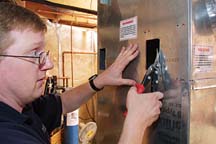
Robin Pharo is product manager for Aprilaire’s UV Products, Madison, Wis. She agreed “absolutely” that some contractors are skeptical. This could be because “A lot of companies weren’t straightforward about UV when it first came out, when it works and when it doesn’t,” she explained.
“There are a lot of contractor questions on the application,” she said. Many contractors, for instance, wonder what types of applications would benefit from UV lights and where they should be placed for ideal performance.

Residential Placement
The biggest questions from contractors are on placement, Pharo said. For instance, should UVGIs be installed in the return or supply?For airstream coverage, the study “Defining the Effectiveness of UV Lamps Installed in Circulating Air Ductwork,” from the Air-Conditioning & Refrigeration Technology Institute (ARTI), recommends placement in the return side, with six lamps for optimum effectiveness, Pharo pointed out.
Due to space and financial constraints, however, “Most homeowners won’t have that many lamps installed. So we recommend the concurrent installation of a really good filter, with the UV lamp placed over the indoor coil,” Pharo said. “Air conditioning systems are great inventions, but the moist environment (at the coils) creates a microbial breeding ground.”
Additionally, when UV lamps are shining directly on the coils, they are hitting a stationary target. When moving targets (VOCs and microbes) pass UV lights, the more sensitive microbes may be damaged but the hardier ones will pass unharmed. Pharo compared this to her own fair skin, which burns even after only short periods in the sun. Her husband, on the other hand, has skin that needs a lot more exposure in order to burn.
According to the ARTI study, “vegetative bacteria were most susceptible to UVGI, bacteria and fungal spores being substantially more resistant.”
Even with the smaller configuration at the indoor coil, space availability “is a concern,” Pharo said. “Installation depends on system design. In most cases, one or two units can be placed for adequate coverage.”
Pharo had UVGI installed in her home before Aprilaire’s product was released for general sale. “We had to put one horizontal and one perpendicular,” she said. No one has allergies per se in Pharo’s household, but there are three dogs and three birds.

Residential Usage
“We recognize that it’s not suited for all applications,” she said. The company’s UVGI is better suited for climates where air conditioning is run frequently, she indicated.“When I run my air conditioning, the UV lamp prevents microbial growth on the coil,” she stated. “It doesn’t allow the opportunity for mold to grow, so my coils look as new as they did the day they were installed.”
The installation of new coils is an ideal time to install UVGI lamps. It can also be recommended and installed ideally at coil cleaning time during seasonal preventive maintenance calls. “Clean the coils first, then install the UV lamp,” Pharo said.
She offered one product caution: “Some heat pumps have an antimicrobial coating on the coils. This is not recommended for use with UV products.”
Overall consumer awareness of IAQ products is high and getting higher, she concluded. Contractors may be concerned that consumers aren’t aware of the validity of today’s UVGI products for smaller applications, but, “This is why we also offer third-party recommendations,” Pharo said.
It’s also critical that anyone selling or recommending UVGI products not promise too much, especially regarding protection against bioterrorism.
In its report, ARTI calls UVGI “a low-pressure-drop, nonintrusive technology that has real potential.” However, “ARTI recommends, as a result of this research, that test methods and guidance for performance claims regarding bioaerosol and bioterrorism agents be developed by an experienced and broadly based group of technical experts, users, and manufacturers.
“Until rigorous and adequate tests have been developed and performed, claims regarding protection against aerosol bioterrorism agents are suspect.” The institute said it will be working with the appropriate federal agencies “to encourage further the development of a complete empirical database of UVGI effectiveness.”
Sidebar: Free UV Lamp Study Available
ARLINGTON, Va. — The Air-Conditioning & Refrigeration Technology Institute’s (ARTI’s) study, “Defining the Effectiveness of UV Lamps Installed in Circulating Air Ductwork,” tested UVGI lamp efficacy to inactivate microbial aerosols in ventilation ducts. The subsequent report offers important information for designers, practitioners, and forensic scientists.The final report can be downloaded without charge from the ARTI’s Web site, www.arti-21cr.org.
UVGI lamps have been around for a quite some time — since about 1900 — but until recently they were most often used for inactivating microbial aerosols; therefore, most prior research has focused on the control of infectious diseases, such as tuberculosis in medical facilities. “The rise in residential and commercial indoor environmental quality (IEQ) problems has resulted in increased use of UVGI lamps in ventilation ducts,” ARTI pointed out. “These in-duct applications are generally concerned with controlling environmental organisms.”
The performance equation commonly cited in the literature for UVGI inactivation was found to generally apply, provided its parameters were known. The key factors for the design of in-duct UVGI systems intended to disinfect moving airstreams were determined to be:
1. UV lamp irradiance at operating conditions;
2. Microbial resistance data;
3. Having a tested and functioning bioaerosol dose model; and
4. Duct wall reflectance.
“Given this information, UVGI system designers can make reasonable and responsible performance estimates for most in-duct applications.”
— B. Checket-Hanks
Publication date: 06/30/2003

Report Abusive Comment